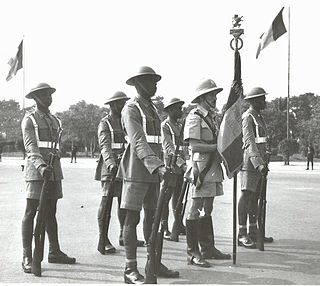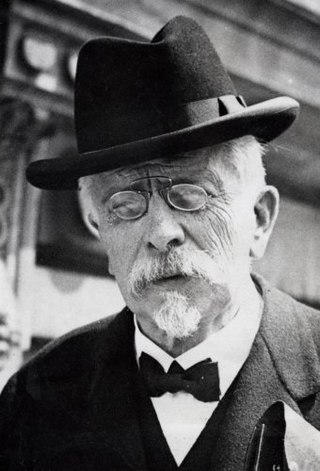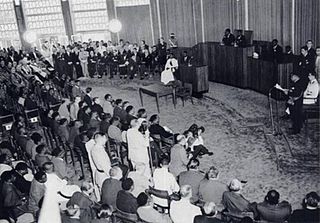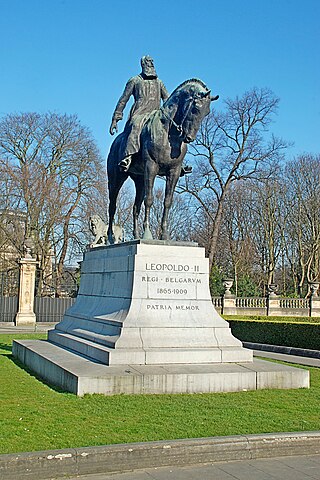Related Research Articles

Leopold II was the second King of the Belgians from 1865 to 1909, and the founder and sole owner of the Congo Free State from 1885 to 1908.

The Belgian Congo was a Belgian colony in Central Africa from 1908 until independence in 1960 and became the Republic of the Congo (Léopoldville). The former colony adopted its present name, the Democratic Republic of the Congo (DRC), in 1964.

The Congo Free State, also known as the Independent State of the Congo, was a large state and absolute monarchy in Central Africa from 1885 to 1908. It was privately owned by King Leopold II, the constitutional monarch of the Kingdom of Belgium. In legal terms, the two separate countries were in a personal union. The Congo Free State was not a part of, nor did it belong to Belgium. Leopold was able to seize the region by convincing other European states at the Berlin Conference on Africa that he was involved in humanitarian and philanthropic work and would not tax trade. Via the International Association of the Congo, he was able to lay claim to most of the Congo Basin. On 29 May 1885, after the closure of the Berlin Conference, the king announced that he planned to name his possessions "the Congo Free State", an appellation which was not yet used at the Berlin Conference and which officially replaced "International Association of the Congo" on 1 August 1885. The Free State was privately controlled by Leopold from Brussels; he never visited it.

The Berlin Conference of 1884–1885 met on 15 November 1884 and, after an adjournment, concluded on 26 February 1885 with the signature of a General Act regulating European colonization and trade in Africa during the New Imperialism period.

The Force Publique was the military of the Congo Free State and the Belgian Congo from 1885 to 1960. It was established after Belgian Army officers travelled to the Free State to found an armed force in the colony on Leopold II of Belgium's orders. The Force Publique was heavily involved in atrocities in the Congo Free State, and also saw action in the Congo Arab war, World War I and World War II. It was renamed to the Congolese National Army in July 1960 after Congo gained independence from Belgian colonial rule.

Belgium controlled several territories and concessions during the colonial era, principally the Belgian Congo from 1908 to 1960, Ruanda-Urundi from 1922 to 1962, and Lado Enclave from 1884 to 1910. It also had small concessions in Guatemala (1843–1854) and Belgian concession of Tianjin in China (1902–1931) and was a co-administrator of the Tangier International Zone in Morocco.

Félicien Cattier (1869–1946) was a very prominent Belgian banker, financier and philanthropist. He was also professor of law at the Free University of Brussels. He was governor of the powerful trust, the Société Générale de Belgique and chairman of the Union minière du-Haut-Katanga amongst many other companies.

The Belgian Minister of the Colonies was a Belgian parliamentarian who was responsible for the territories of the colonial empire in Central Africa from 1908 to 1962, comprising the colony of the Belgian Congo (1908–60) and the international mandate of Ruanda-Urundi (1916–62). The exact title was changed on several occasions.

Belgium–Congo relations refers to relations between the Kingdom of Belgium and the Democratic Republic of the Congo. The relationship started with the exploration of the Congo River by Henry Morton Stanley.

The Speech at the Ceremony of the Proclamation of the Congo's Independence was a short political speech given by Patrice Lumumba on 30 June 1960 at the ceremonies marking the independence of the Republic of Congo from Belgium. It is best known for its outspoken criticism of colonialism.

The involvement of the Belgian Congo in World War II began with the German invasion of Belgium in May 1940. Despite Belgium's surrender, the Congo remained in the conflict on the Allied side, administered by the Belgian government in exile.

The Léopoldville riots were an outbreak of civil disorder in Léopoldville in the Belgian Congo which took place in January 1959 and which were an important moment for the Congolese independence movement. The rioting occurred when members of the Alliance des Bakongo (ABAKO) political party were not allowed to assemble for a protest and colonial authorities reacted harshly. The exact death toll is not known, but at least 49 people were killed and total casualties may have been as high as 500. Following these riots, a round table conference was organized in Brussels to negotiate the terms of Congo's independence, The Congo received its independence on 30 June 1960, becoming the Republic of the Congo.
White Congolese are the people from the Democratic Republic of the Congo who are of European descent and are not part of another racial group.

From 1885 to 1908, many atrocities were committed in the Congo Free State under the absolute rule of King Leopold II of Belgium. These atrocities were particularly associated with the labour policies, enforced by colonial administrators, used to collect natural rubber for export. Combined with epidemic disease, famine, and falling birth rates caused by these disruptions, the atrocities contributed to a sharp decline in the Congolese population. The magnitude of the population fall over the period is disputed, with modern estimates ranging from 1.5 million to 13 million. The atrocities have been variously referred to as the Rubber Terror and by some as the Congolese Genocide, though the latter characterization is disputed.
Banana District was a district of the Congo Free State and Belgian Congo. It disappeared in a reorganization of 1910.

The Colonial University of Belgium was an institute of higher education located in Antwerp. Founded in 1920, the institute was established to prepare students for a careers as colonial functionaries in the Belgian Congo and Ruanda-Urundi. It was renamed the University Institute of Overseas Territories in 1949. It was dissolved in 1962.
The following lists events that happened during 1908 in the Congo Free State.
The following lists events that happened during 1908 in the Belgian Congo.
Relations between the Congo Free State and the United States began after recognition between the two states in 1885 when the Congo Free State was established. After Belgium under Leopold II annexed the Congo Free State in 1908, later becoming Belgian Congo, relations ceased between the two nations.

The equestrian statue of Leopold II is a bronze equestrian statue erected in Brussels, Belgium, in memory of King Leopold II, second King of the Belgians. It was created by the sculptor Thomas Vinçotte in 1914, but it was not finalised until 1926 by the architect François Malfait, when it was inaugurated in honour of the king.
References
- ↑ Pakenham, Thomas (1992). The Scramble for Africa: the White Man's Conquest of the Dark Continent from 1876 to 1912 (13th ed.). London: Abacus. pp. 253–5. ISBN 978-0-349-10449-2.
- ↑ Pakenham, Thomas (1992). The Scramble for Africa: the White Man's Conquest of the Dark Continent from 1876 to 1912 (13th ed.). London: Abacus. pp. 588–9. ISBN 978-0-349-10449-2.
- ↑ Vanthemsche, G. (2012). Belgium and the Congo, 1885-1980. New York: Cambridge University Press. p. 41. ISBN 978-0-521-19421-1.
- ↑ Senelle, R., and E. Clément (2009), Léopold II et la Charte Coloniale, Brussels: Editions Mols.
- ↑ Vanthemsche, G. (2012). Belgium and the Congo, 1885-1980. New York: Cambridge University Press. p. 41. ISBN 978-0-521-19421-1.
- ↑ Polasky J. (1995). The democratic socialism of Emile Vandevelde: Between Reform and Revolution. Berg, Oxford/Washington D.C., Chapter 3. ISBN 1 85973 033 7